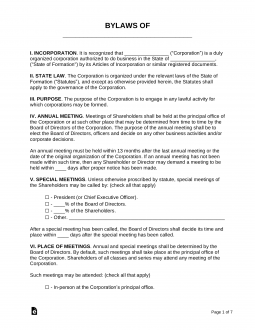Updated February 01, 2024
Corporate bylaws outline the ownership structure, business operations, and management of a corporation. The bylaws are written by the initial directors, who are typically named in the articles of incorporation filed with the Secretary of State. After the bylaws are created, the document should be signed by each director.
By State
- Alabama
- Alaska
- Arizona
- Arkansas
- California
- Colorado
- Connecticut
- Delaware
- Florida
- Georgia
- Hawaii
- Idaho
- Illinois
- Indiana
- Iowa
- Kansas
- Kentucky
- Louisiana
- Maine
- Maryland
- Massachusetts
- Michigan
- Minnesota
- Mississippi
- Missouri
- Montana
- Nebraska
- Nevada
- New Hampshire
- New Jersey
- New Mexico
- New York
- North Carolina
- North Dakota
- Ohio
- Oklahoma
- Oregon
- Pennsylvania
- Rhode Island
- South Carolina
- South Dakota
- Tennessee
- Texas
- Utah
- Vermont
- Virginia
- Washington
- Washington D.C.
- West Virginia
- Wisconsin
- Wyoming
Table of Contents |
What are Corporate Bylaws?
Corporate bylaws are created by the board of directors who are usually the shareholders of the corporation and listed on the articles of incorporation. Once complete, a copy of the bylaws should be kept at the principal place of business and updated after each meeting, if necessary.
What Should be Included?
- Name of Corporation
- Board of Directors
- Stock Certificates
- What Determines a Quorum
- Voting Rights
- Date and Time of Annual Meetings
- Committees
- Indemnification
- Other Individuals (officers, members, etc.)
What is a Quorum?
A quorum is a minimum number of directors or shareholders that is required to have a meeting. It is common to have a majority or at least 50% of individuals present to constitute a quorum.
Are Corporate Bylaws Required?
Corporate bylaws are required in the following 31 states:
| State | Required? | Statute |
| Alabama | Yes | § 10A-2A-2.05(a) |
| Alaska | No | AS 10.06.228, AS 10.06.230, AS 10.06.233 |
| Arizona | Yes | ARS 10-206(A) |
| Arkansas | Yes | § 4-27-206(a) |
| California | No | § 210, § 211, § 212, and § 213 |
| Colorado | No | § 7-102-106 |
| Connecticut | Yes | § 33-640(a) |
| Delaware | No | § 109 |
| Florida | Yes | § 607.0207(1) |
| Georgia | Yes | § 14-2-206(a) |
| Hawaii | Yes | § 414-36(a) |
| Idaho | Yes | § 30-29-206(a) |
| Illinois | No | 805 ILCS 5/2.25 |
| Indiana | Yes | § 23-1-21-6(a) |
| Iowa | No | § 490.206(1) |
| Kansas | No | § 17-6009 |
| Kentucky | Yes | § 2-060(1) |
| Louisiana | No | RS 12:1-206 |
| Maine | Yes | 13-C §206(1) |
| Maryland | Yes | § 2-109(a)(1) |
| Massachusetts | Yes | Ch. 156D § 2.06(a) |
| Michigan | No | § 450.1223 |
| Minnesota | No | § 302A.181(1) |
| Mississippi | No | § 79-4-2.06 |
| Missouri | No | § 351.290(1) |
| Montana | Yes | § 35-14-206(1) |
| Nebraska | Yes | § 21-224(a) |
| Nevada | No | NRS 78.120(2) |
| New Hampshire | Yes | § 293-A:2.06(a) |
| New Jersey | Yes | § 14A:2-9(1) |
| New Mexico | Yes | § 53-11-27 |
| New York | Yes | BSC § 601(a) |
| North Carolina | Yes | § 55-2-06(a) |
| North Dakota | No | § 10-19.1-31(1) |
| Ohio | No | § 1701.11 |
| Oklahoma | Yes | § 18-437.6 |
| Oregon | Yes | § 60.061 |
| Pennsylvania | No | § 1504 |
| Rhode Island | No | § 7-1.2-203 |
| South Carolina | Yes | § 33-2-106(a) |
| South Dakota | Yes | § 47-1A-206 |
| Tennessee | Yes | § 48-12-106(a) |
| Texas | Yes | § 21.057(a) |
| Utah | No | § 16-10a-206 |
| Vermont | Yes | 11V.S.A. § 2.06(a) |
| Virginia | Yes | § 13.1-624(a) |
| Washington | Yes | § 23B.02.060(1) |
| Washington D.C. | Yes | § 29–302.06 |
| West Virginia | Yes | § 31D-2-205(a) |
| Wisconsin | No | § 180.0206 |
| Wyoming | Yes | § 17-16-206(a) |
How to Create Bylaws (5 steps)
Creating bylaws involves the initial incorporators of the entity writing a simple agreement of the rules for decision-making and when annual meetings are to occur.
Step 1 – Gather the Incorporators

The initial incorporators or shareholders who currently own the company will select the leaders of the business moving forward. In most states, it is required that a majority of the shareholders, either majority or two-thirds vote, to make the initial decisions.
Step 2 – Select the Initial Directors and Chairperson

Also known as a board of directors, these individuals will be the primary decision-makers of the business. Usually, the individuals with a majority of shares will be nominated to the board with a chairperson that controls the meetings. For annual meetings to occur, a minimum number or percentage of the board of directors must be present at the meeting.
Step 3 – Create the Rules for the Entity

Once the initial directors have been selected they can begin to make rules for the entity. Rules to be decided on include:
- How business decisions are made
- When and where annual meetings are to occur
- Percent of shareholders needed to make decisions
- When and how dividends are paid
- Roles for each officer or member
Step 4 – Write the Corporate Bylaws

Download and fill out the corporate bylaws template. In most states, a secretary for the business or other administrative person needs to sign for the agreement to be in effect.
However, it is recommended that a majority of the shareholders sign the bylaws and notarize the document using a notary acknowledgment.
Step 5 – Schedule Meetings and Amend

After the corporate bylaws have been written, the board of directors can start business activities by obtaining an Employer Identification Number (EIN) from the IRS. Bank accounts can be created in addition to hiring employees and making meetings and further amending the corporate bylaws as the business changes.
For-Profit vs. Non-Profit
For-Profit
- Higher registration and renewal fees
- Profits after expenses are distributed to the shareholders
- Salaries can be adjusted at any time
- Register at the State only (EIN required by IRS)
- Employees are paid
Non-Profit
- Lower registration and renewal fees
- Profits after expenses must be to a “worthy cause” (find out in IRS)
- Salaries of individuals must be set at the start of the year
- Register federally and with the state
- Employees are mainly volunteers
Frequently Asked Questions (FAQs)
- Who Can Amend Corporate Bylaws?
- Are Corporate Bylaws a Public Record?
- Who Signs the Corporate Bylaws?
Who Can Amend the Corporate Bylaws?
The bylaws can only be amended by the directors and/or shareholders in an official meeting. The rules of amending should be located in the most updated version of the bylaws.
Are Corporate Bylaws a Public Record?
No. Unlike the articles of incorporation which are public in most states, bylaws are a private document kept at the principal place of business.
Who Signs the Bylaws?
Bylaws are not required to be signed. It is recommended that they be signed by the corporation’s secretary or the chairman of the board, but it is not a requirement.
Sample – Corporate Bylaws
BYLAWS OF
[NAME OF CORPORATION]
I. INCORPORATION. It is recognized that [NAME OF CORPORATION] (“Corporation”) is a duly organized corporation authorized to do business in the State of [STATE OF FORMATION] (“State of Formation”) by its Articles of Incorporation or similar registered documents.
II. STATE LAW. The Corporation is organized under the relevant laws of the State of Formation (“Statutes”), and except as otherwise provided herein, the Statutes shall apply to the governance of the Corporation.
III. PURPOSE. The purpose of the Corporation is to engage in any lawful activity for which corporations may be formed.
IV. ANNUAL MEETING. Meetings of Shareholders shall be held at the principal office of the Corporation or at such other place that may be determined from time to time by the Board of Directors of the Corporation. The purpose of the annual meeting shall be to elect the Board of Directors, officers and decide on any other business activities and/or corporate decisions.
V. SPECIAL MEETINGS. Unless otherwise proscribed by statute, special meetings of the Shareholders may be called by: (check all that apply)
☐ – President (or Chief Executive Officer).
☐ – [#]% of the Board of Directors.
☐ – [#]% of the Shareholders.
☐ – Other. [OTHER]
After a special meeting has been called, the Board of Directors shall decide its time and place within [#] days after the special meeting has been called.
VI. PLACE OF MEETINGS. Annual and special meetings shall be determined by the Board of Directors. By default, such meetings shall take place at the principal office of the Corporation. Shareholders of all classes and series may attend any meeting of the Corporation.
Such meetings may be attended: (check all that apply)
☐ – In-person at the Corporation’s principal office.
☐ – Via remote communication, the method to be determined by the Board of Directors.
☐ – Other. [OTHER]
All communication methods shall offer each attending Shareholder the right to be present, vote on business matters, and provide their consent or dissent for any actionable item.
VII. DISSOLUTION. The Corporation may only be dissolved in the following ways: (check all that apply)
☐ – [#]% vote by the Board of Directors.
☐ – [#]% vote by the Shareholders.
☐ – Other. [OTHER]
VIII. NOTICE OF MEETINGS. Written notice shall be provided to each Shareholder of any meeting that such Shareholder is permitted to take action in the form of a vote and/or offer their consent or dissent for any actionable item.
Notice of any meeting can be sent to the Shareholders by the following method(s): (check all that apply):
☐ – E-Mail.
☐ – Mailing Address via United States Mail (postage paid by the Corporation).
☐ – Fax.
☐ – Hand-Delivered.
☐ – Other. [OTHER]
IX. QUORUM. A quorum, which represents the required number of individuals to be present to hold an annual or special meeting, shall be: (check all that apply)
☐ – [#]% of the Board of Directors being present.
☐ – [#]% of the Shareholders being present.
☐ – Other. [OTHER]
Upon meeting the requirements of the quorum, the attending individuals of the meeting shall be able to take action and make decisions for the Corporation.
X. ACTIONS OF THE CORPORATION. Actions made on behalf of the Corporation must be: (check one)
☐ – Made with a Meeting ONLY. Any action required to be taken or which may be taken at any meeting, whether annual or special, must be taken with a meeting, in accordance with these Bylaws.
☐ – Can be Made WITHOUT a Meeting. Any action required to be taken or which may be taken at any meeting, whether annual or special, may be taken if consent is in writing.
XI. CORPORATE SEAL. The Corporation shall: (check one)
☐ – HAVE a Corporate Seal. The corporate seal shall be in such form that the Board of Directors shall approve.
☐ – NOT HAVE a Corporate Seal.
XII. EXECUTION OF DOCUMENTS. All contracts, checks, drafts, demands for money, notes, and other legal instruments or rights of any nature of the Corporation may be signed by: (check all that apply)
☐ – Board of Directors.
☐ – Chairperson.
☐ – President.
☐ – Treasurer.
☐ – Secretary.
☐ – Other. [OTHER]
XIII. INDEMNIFICATION. Subject to any applicable statute, any Director or Officer of the Corporation shall: (check one)
☐ – BE INDEMNIFIED and held harmless by the Corporation to the fullest extent of the law.
☐ – NOT BE INDEMNIFIED or held harmless in any way by the Corporation.
XIV. AMENDMENTS. These Bylaws may be amended by: (check all that apply):
☐ – [#]% vote of the Board of Directors.
☐ – [#]% vote of the Shareholders.
☐ – Other. [OTHER]
XV. STOCK CERTIFICATES. The Corporation may provide shares of stock: (check one)
☐ – WITH CERTIFICATES. The Corporation, within a reasonable time after issue or transfer of shares without certificates, provide Shareholders a written statement of the information that is required by law to be on the certificates.
☐ – WITHOUT CERTIFICATES. The Corporation, within a reasonable time after issue or transfer of shares without certificates, provide Shareholders a written statement of the information that is required by law to be on the certificates.
XVI. DIRECTORS. The Corporation shall be managed by [#] Directors, who together constitute the Board of Directors.
XVII. CONFLICT OF INTEREST. A Director of the Corporation has a conflict of interest if the Director has an existing or potential business, financial or personal interest or holds an elected or appointed position that could impair or might reasonably appear to impair the exercise of independent, unbiased judgment in the discharge of his or her responsibilities to the Corporation.
XIX. LIST OF SHAREHOLDERS. The officer of the Corporation who has charge of the stock ledger of the Corporation shall prepare and make, at least ten (10) days before any meeting of Shareholders, a complete list of the Shareholders entitled to vote at the meeting, arranged alphabetically, and showing the address of each Shareholder and the number of shares held by each Shareholder.
XX. CERTIFICATION. The original, or a copy of these bylaws, as amended or otherwise altered to date, certified by the Secretary, shall be kept at the Corporation’s principal executive office and shall be open to inspection by the stockholders of the Corporation, at all reasonable times during office hours.
By the signature below, these bylaws are hereby certified to be a complete and correct copy of the above-named Corporation, duly adopted by the initial Board of Directors on [DATE].
By: _________________________________ Date: ________________
Print Name: _________________________________ Title: ________________
Related Forms
Download: PDF, MS Word, OpenDocument



